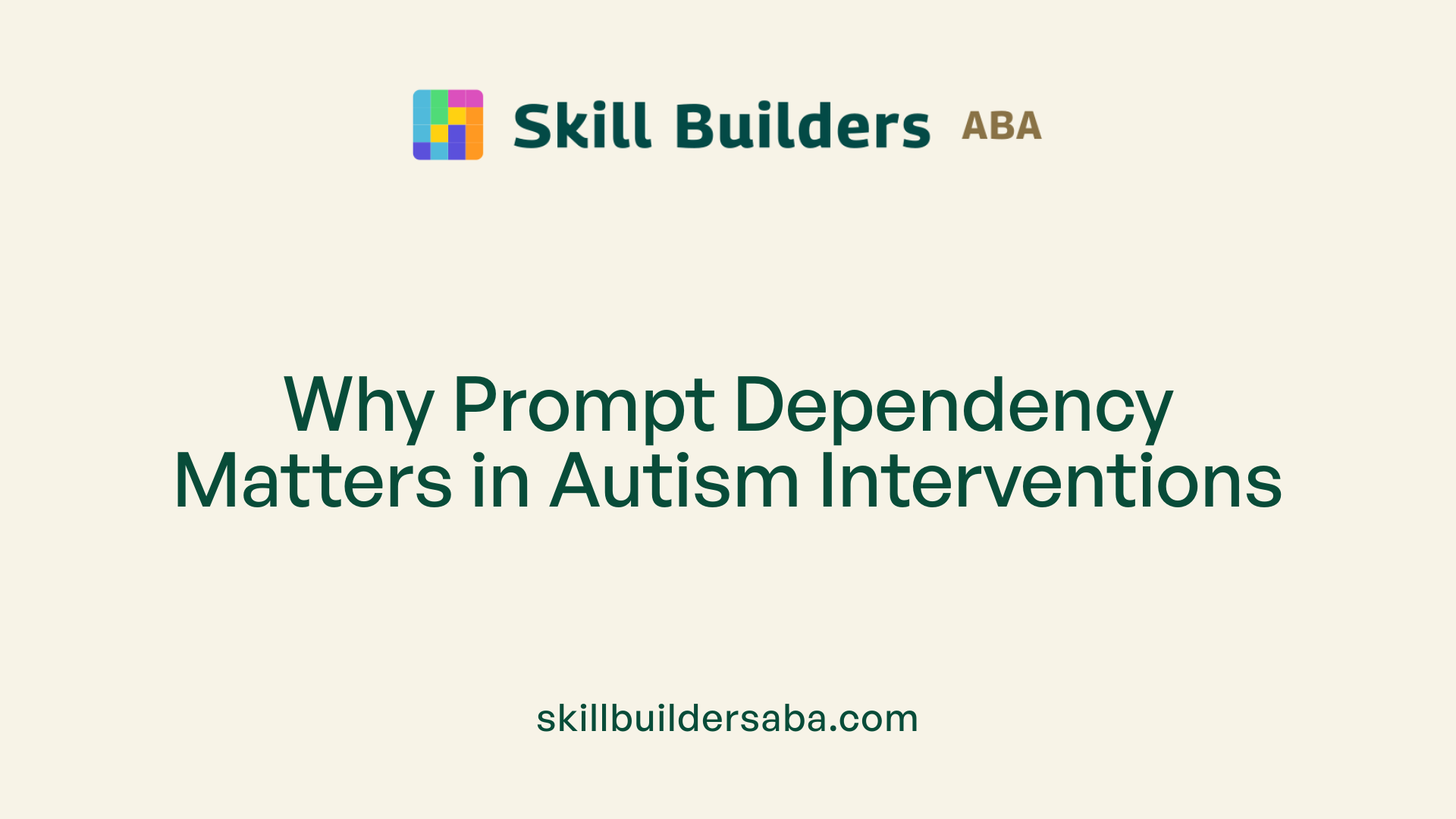How to reduce prompt dependency in ABA
Strategies for Fostering Independence in ABA Therapy

Understanding Prompt Dependency and Its Impact
Prompt dependency occurs when individuals, particularly children with autism spectrum disorder (ASD), rely heavily on adult prompts to perform tasks they are capable of doing independently. This reliance can hinder natural learning processes, increase supervision needs, and reduce overall competence. Recognizing and addressing prompt dependency is essential in ABA therapy to promote autonomous functioning and skill generalization. This article explores effective methods for reducing prompt dependency to enhance independence in learners.
Defining Prompt Dependency and Its Significance

What does prompt dependency mean in autism?
Prompt dependency is a situation where a learner's correct responses are primarily triggered by prompts rather than occurring independently. According to Clark and Green (2004), prompt dependency is when an individual's successful responding relies heavily on the controlling prompt from the therapist, with minimal progress observed in fading those prompts. This often means the learner isn't truly mastering the skill but is instead awaiting cues before acting.
This dependence can hinder the development of spontaneous, independent behaviors and can make learning fragile, as the learner may struggle to perform skills without prompts.
Why is prompt dependency a concern in ABA?
Prompt dependency is a common issue, especially among children with autism spectrum disorder (ASD). It can lead to distraction, requiring constant supervision and support, which limits the learner's ability to generalize skills across environments.
It also results in passive learning, where the child may become overly reliant on external assistance rather than developing internal motivation or automatic responses. Over time, this can stagnate progress and reduce the effectiveness of intervention strategies.
Educational and therapeutic goals focus on fostering independence. When prompt dependency occurs, it undermines these goals and can prolong the learning process.
Various strategies, such as prompt fading, reinforcement, and visual supports, are employed to counteract this dependency. These techniques aim to gradually reduce prompts, encouraging learners to respond on their own.
Research highlights the importance of early identification and systematic fading of prompts to promote autonomous responding. For instance, the use of least-to-most prompting hierarchies, combined with reinforcement, helps reduce prompt reliance.
Strategies to address prompt dependency include:
- Planning prompt fading from the start.
- Using natural cues and visual supports.
- Implementing time delays like pausing after a prompt.
- Reinforcing independent responses.
- Involving caregivers to ensure consistency across settings.
Addressing prompt dependency not only improves skill independence but also enhances motivation and generalization, leading to better overall learning outcomes for children with ASD.
Understanding the Causes and Preventive Strategies

Why does prompt dependence occur and how can it be prevented?
Prompt dependence develops when a learner, often a child with autism or other developmental challenges, begins to rely heavily on adult prompts to perform skills. This reliance usually results from prompts not being systematically faded during instruction, meaning the individual cannot perform the skill independently without ongoing cues.
Such dependency can hinder progress, cause distractions, and require constant supervision, making learning less natural and more passive. To prevent prompt dependence from the outset, it is essential to incorporate prompt fading strategies into the initial teaching plan.
Planning ahead involves selecting the least intrusive prompts—such as visual supports or natural cues—and gradually reducing these supports using transfer procedures. Using a hierarchy of prompts, starting with natural cues, then moving to visual supports, gestures, verbal prompts, modeling, and full physical prompts if necessary, is recommended.
Additionally, implementing a deliberate pause, like waiting 3-4 seconds after a natural cue before providing a prompt, encourages the learner to respond independently. Reinforcement plays a vital role; praise and rewards should be given for responses that are independent or only minimally prompted.
Engaging caregivers and teachers in the prompt fading process ensures consistency across different settings, further promoting independence. Regular assessment of prompting levels helps identify overprompting and adjusts strategies accordingly.
Utilizing visual supports such as picture cues, schedules, and labels allows children to use these tools independently, reducing their need for adult prompts. Combining visual supports with strategies like differential reinforcement and extended response intervals fosters a learning environment that encourages autonomous responses.
In sum, a proactive approach—integrating prompt fading strategies, visual supports, reinforcement, and ongoing assessment—significantly reduces the risk of prompt dependency, enabling learners to perform skills more naturally and independently.
Effective Strategies for Prompt Fading and Reinforcement

How can prompts be faded effectively to encourage autonomous responses?
Prompts can be faded successfully by thoughtfully reducing the level of support as the learner begins to respond more independently. Implementing a systematic approach—such as moving from least intrusive prompts like natural cues and visual supports, gradually progressing to more supportive prompts when necessary—is crucial.
A common method is the 'least to most' hierarchy, where prompts start with minimal assistance like a visual cue or gestural prompt, and then escalate to more intrusive prompts only if the learner does not respond. Conversely, the 'most to least' approach begins with full support, gradually fading to less intrusive prompts as responses improve.
Consistent data recording is essential to determine when the learner is ready to move to less support, ensuring prompts are faded at an appropriate pace that fosters independence without causing frustration. Reinforcing responses that occur without prompts, such as praise or other positive reinforcement, also encourages the learner to rely less on prompts.
Practicing skills without prompts repeatedly helps solidify independent responses. Over time, these practices develop natural, spontaneous behaviors, increasing the child's confidence and ability to perform skills without external assistance.
Incorporating strategies such as increasing wait time after providing a natural cue allows the learner more opportunity to respond independently, further reducing prompt dependency.
By combining these methods—systematic fade procedures, reinforcement for independent responses, and consistent data collection—the progress toward autonomous behavior can be effectively supported.
Best Practices for Prompt Minimization
What are best practices for minimizing prompt use in ABA interventions, especially for individuals with autism?
To effectively reduce reliance on prompts, practitioners should always incorporate prompt fading strategies into the initial teaching plan. This involves designing clear methods for gradually decreasing support from the beginning, ensuring that the learner gains independence over time.
Employing a least-to-most prompting hierarchy is a widely recommended approach. Starting with the least intrusive prompts, such as natural cues and visual supports, and progressing to more direct prompts like gestural, verbal, modeling, and physical assistance as needed helps avoid prompt dependency.
A crucial technique is to implement a time delay, such as pausing for 3-4 seconds after a natural cue before providing additional prompts. This encourages the learner to respond independently without immediate assistance.
Visual supports play a vital role; these are prompts that the learner can utilize independently, such as schedules, picture cues, and labels. They foster autonomous responses and reduce the need for direct prompts from caregivers or teachers.
Reinforcement and shaping responses are also essential. Providing praise and reinforcement for responses that are not perfect initially, then gradually increasing the accuracy requirements, supports independent learning.
Assessing for overprompting is necessary for educators and caregivers; recognizing when prompts are excessive allows for strategic adjustments, promoting greater independence.
Consistency in reinforcement combined with systematic prompt fading can significantly decrease prompt dependency over time. Methods such as differential reinforcement, extended response intervals, and physical prompts with prompt delays have proven effective.
Research shows that strategies like video modeling, self-monitoring, and individual work systems further encourage independent behaviors. Using Differential Observing Responses (DORs), where learners name or observe stimuli before responding, increases correct responses and minimizes impulsivity.
When teaching communication skills, especially with AAC devices, it is helpful to incorporate identity matching alongside DORs. Combining prompt fading with these methods optimizes outcomes.
Overall, embedding these best practices—initial planning, gradual fading, visual supports, reinforcement, and caregiver training—can effectively minimize prompt use, foster independence, and reduce prompt dependency in learners with autism.
Utilizing Visual Supports and Technology in Prompt Reduction

What techniques can be used to reduce prompt dependency during FCT or with AAC learners?
Strategies to diminish prompt reliance incorporate several evidence-based approaches. First, systematic prompt fading gradually reduces the level of support provided, whether visual, verbal, or physical. This process ensures learners gain independence without becoming overly dependent on prompts.
Another effective method is to implement 'Potent Pause' techniques—pausing for 3-4 seconds after a natural cue, while maintaining an expectant posture. This extension encourages the learner to respond independently before additional prompts are given.
Video modeling also plays a significant role. By recording the learner performing skills without prompts and editing these videos for clarity, teachers can provide visual demonstrations of successful independent responses. This modality leverages visual learning strengths and can be particularly effective for children with cognitive challenges.
Involving learners directly in monitoring their own progress through self-assessment charts or checklists further promotes independence. When learners see their growth, they gain confidence and motivation to rely less on prompts.
Overall, combining these strategies—prompt fading, purposeful pause, video modeling, and self-monitoring—creates a supportive environment that nurtures autonomous communication and minimizes prompt dependency.
Examples of visual supports
Visual supports encompass a wide range of tools designed to assist learners in understanding and initiating responses with minimal prompts. These include visual schedules that outline daily routines, picture cues that represent common requests or objects, labels that help in vocabulary building, visual recipes for tasks, and directional arrows guiding movements or sequences.
Using visual cues as prompts allows students to access information independently, reducing the need for direct prompts from adults. For example, a picture symbol on a schedule can remind a child of the next activity, while pointing to a visual card can prompt specific actions.
Role of video modeling and AAC
Video modeling is a research-backed strategy that can significantly boost independent responses. Teachers record learners performing tasks or skills without prompts, edit the videos to highlight success, and then have the student watch these videos repeatedly. This process exploits visual learning and provides clear examples of expected behaviors.
Augmentative and Alternative Communication (AAC) tools also benefit from visual supports and video modeling. AAC devices often incorporate symbol-based interfaces that support expression with minimal prompts. Modeling how to use AAC tools in natural contexts encourages learners to imitate and eventually perform communication acts independently.
Together, visual supports and video modeling form a powerful duo to help children with autism develop autonomous communication skills, reducing prompt dependency over time.
Promoting Lasting Independence
Reducing prompt dependency is essential for fostering genuine independence in learners undergoing ABA therapy. By systematically fading prompts, utilizing natural cues, reinforcing unprompted responses, and involving caregivers, practitioners can help individuals develop skills that are functional and adaptable across settings. Consistent, research-based strategies such as visual supports, timely delays, and differential reinforcement are key components to achieve this goal. Overall, a strategic, individualized approach ensures that learners gain confidence in their abilities, leading to more autonomous and natural behaviors.
References
- How to Reduce Prompt Dependence - The Autism Helper
- Comparison of Prompting Strategies on Two Types of Tasks With ...
- Addressing Prompt Dependency in the Treatment of Challenging ...
- Reducing Prompt Dependence in AAC Learners: 5 Things to Try
- Prompt Fading Helps Children with Autism Become Independent
- What is Prompt Dependency in Children with Autism?
- Prompt Dependency - Communication Matrix
- Reduce & Prevent Prompt Dependent Behaviors - Mrs. P's Specialties
- 5 Tips to Prevent Prompt Dependency - Sunny Days Sunshine Center
- How to Reduce Prompt Dependence - The Autism Helper
.svg)














